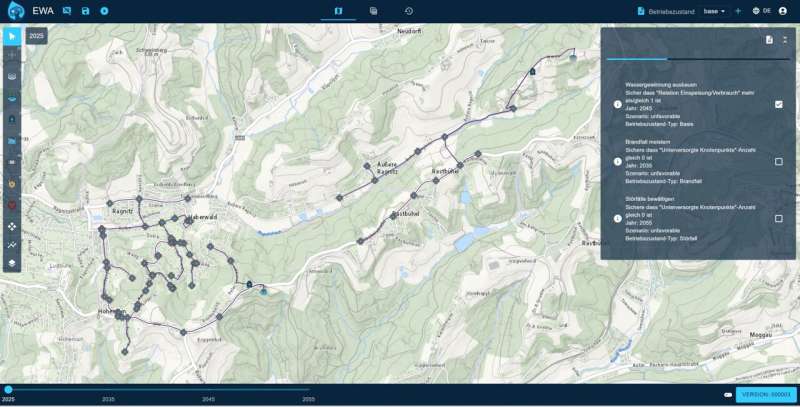This article has been reviewed according to Science X's editorial process and policies. Editors have highlighted the following attributes while ensuring the content's credibility:
fact-checked
trusted source
proofread
Research team provides water planning tool with future forecasts up to 2055

In view of demographic changes and advancing climate change, Austria is already experiencing increasingly tense water supply situations, which will only increase in the future. Until now, however, conventional planning systems have not been able to provide a step-by-step forecast of the performance of water supply systems.
A team led by Daniela Fuchs-Hanusch from the Institute of Urban Water Management and Landscape Water Engineering at Graz University of Technology (TU Graz) has developed a solution to this problem. With the free web tool EWA (translator's note: the German acronym stands for "Decision-making tool for water supplies taking into account change factors"), suppliers can run through planning alternatives for various climate, resource and consumption scenarios in a gamified form.
Forecast until 2055
This enables smaller water suppliers, for example, to assess the suitability of their own network for different developments in ten-year increments up to 2055. They can plan the expansion or conversion of their network inside the tool and check whether the planned measures are sufficient or whether further steps need to be taken. Tutorial tasks are available to get familiar with the system—for example, building new wells and pipes for a community so that all residents will still have water in 2055.
In addition, users can put together their own challenges to run through various scenarios or incidents. A budget limit can also be created for these self-created tasks in order to work out the solution to the problem on the basis of the users' own cost estimates. This allows water suppliers in particular to customize their systems and meet their own requirements. One challenge may be that the supply of water in two municipalities will no longer function in 2055 due to the increase in population and visitors, resulting in major bottlenecks in the event of a fire or incident. Using the EWA tool, practicable solutions can be worked out.
Better solution for optimization tasks
Among other things, the study "Austria's water resources" published in 2021, which analyzed the current water demand at the time and developments over the next 30 years with regard to climate change, was incorporated into the development of the tool. In addition, the researchers derived water demand forecasts based on localized water supply data and coordinated with the project partners, the federal states of Styria, Carinthia, Upper Austria and Salzburg, as well as the Federal Ministry of Agriculture, Forestry, Regions and Water Management and three water supply companies.
From this, the team derived performance indicators that a water supply system must fulfill, and developed usable parameters based on the research literature. These were modeled together with the forecasts and hydraulic simulation software and linked to a user interface. Johanna Pirker, Valentin Adler and Georg Arbesser-Rastburg at the Institute of Interactive Systems and Data Science were responsible for implementing the gamified aspects of the tool.
Daniela Fuchs-Hanusch says, "The impact of climate change on the use and availability of water in water-rich Austria is becoming ever greater. It was therefore important to us in the project to combine engineering knowledge with gamification elements in such a way that optimizations for the water supply can be solved just as well, or perhaps even better, than with mathematical optimization algorithms. With the EWA tool, water supply companies can really gauge how their system will react in extreme situations and in the predicted future, and even try out variants in a playful way."
The study is published in the journal Water.
The EWA tool is accessible to all interested users, but for security and data protection reasons a TU Graz account must be created. When creating an account, it is necessary to provide your first name, surname, email address, date of birth and a scan of an official photo ID.
More information: Anika Stelzl et al, Forecasting Urban Peak Water Demand Based on Climate Indices and Demographic Trends, Water (2023). DOI: 10.3390/w16010127
Provided by Graz University of Technology


















